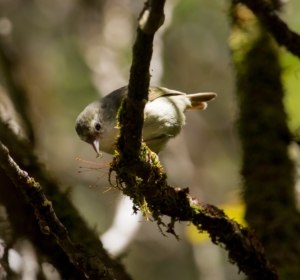 As described in the press release below, the population of endangered ʻakikiki has absolutely plummeted in just the last year. This is extremely disturbing news considering conservationists are working tirelessly to save these birds from the brink of extinction. In an effort to protect these birds, it has been proposed that they be moved to a breeding program on Maui until their habitat can be restored.
As described in the press release below, the population of endangered ʻakikiki has absolutely plummeted in just the last year. This is extremely disturbing news considering conservationists are working tirelessly to save these birds from the brink of extinction. In an effort to protect these birds, it has been proposed that they be moved to a breeding program on Maui until their habitat can be restored.
Some folks wonder, why save one species? What often gets missed is the big picture. It is easy to forget that every species has a role within an ecosystem that supports that ecosystem. For there to be clean water at lower elevations, we must have healthy forests. If we want healthy forests, we must have biodiversity. We must realize that every (native) species contributes to the overall goal of forest health. When the composition of the forest begins to change, there can be cascading consequences downstream. That’s why conservationists work to save species. They are working to save the health of the entire island.
You can read the entire press release below.
(LĪHUʻE) –A shocking drop in numbers of ‘akikiki, an endangered forest bird, was recorded this year at Halehaha, a field site in the central mountains of Kaua’i. Biologists monitoring the area found that the population of more than 70 birds recorded in 2015 had declined to just five in 2021.
The new data, combined with data from other field sites on Kauaʻi where ʻakikiki numbers appear more stable, suggest that Halehaha is currently unsafe as a habitat for ‘akikiki.
Now, the Kaua’i Forest Bird Recovery Project (a partnership with DLNR and the University of Hawai’i Pacific Cooperative Studies Unit) is seeking to protect the remaining birds at Halehaha by moving them temporarily to a breeding program on Maui.
The proposed rescue mission, unanimously approved today by the Board of Land and Natural Resources, highlights a difficult challenge in avian conservation: maintaining the existence of native species when the ecosystems those species rely on have degraded.
In an ideal world, the best location for ‘akikiki to thrive would be in their home forests. At Halehaha, that once-ideal forest is currently out of balance due to the proliferation of invasive species. Surveys at the site have shown a recent increase in invasive mosquitoes that carry avian malaria and other diseases. Moving the remaining birds is a decision of last resort, and likely the only way to keep the population from death.
The interisland transfer of Halehaha’s remaining ‘akikiki is intended to be a temporary reprieve while biologists work to restore the birds’ forest habitat. Cultural practitioners are coordinating with project staff to provide protocol for both the birds’ departure from Kauaʻi and their arrival on Maui at a facility managed by the San Diego Zoo Wildlife Alliance.
The transported ‘akikiki will be in good company on Maui, where the breeding program is already home to roughly 40 ‘akikiki, hatched from eggs collected during previous rescue operations.
The Kauaʻi Forest Bird Recovery Project has previously worked with Ka ʻImi Naʻauao O Hawaiʻi Nei Institute, a Kauaʻi-based group that has provided blessings for the project’s field work. Dawn Kawahara, the institute’s President, commented that the plan “seems to be aligned with what we know and promoting native Hawaiian thought regarding protecting and preserving all life.”
As experts at the Maui breeding facility care for the rescued birds, biologists on Kauaʻi will continue to monitor ʻakikiki remaining in the wild at field sites other than Halehaha. They are also collaborating with experts statewide on developing solutions to restore Hawaiʻi’s native forests as a home for native birds.
The Birds Not Mosquitoes partnership, which includes DLNR and Kauaʻi Forest Bird Recovery Project as members, is currently focused on the potential for a bacterium to act as a mosquito birth control. The tool, also known as Incompatible Insect Technique (IIT), is one of several that biologists could use to reduce the impacts of invasive species. With their forests in better condition, experts foresee a future when Halehaha’s ʻakikiki complete their interisland stay and return home.


